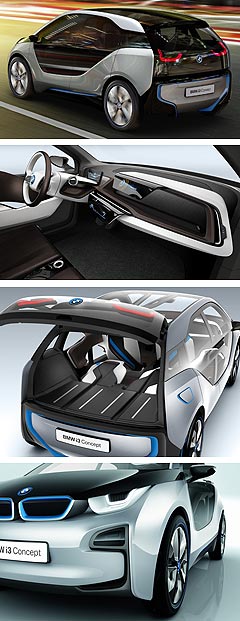Future models - BMW - i3Electric shock: i3 to get range-extenderGo the distance: BMW has pulled a surprise, announcing it will offer an optional range-extending petrol engine in tandem with the i3's electric motor. BMW surprises by announcing an optional range-extending engine for electric city-car1 Aug 2011 By JAMES STANFORD in FRANKFURT BMW will head-off possible range-anxiety concerns for its new i3 electric city-car by offering an optional range-extending combustion engine when it debuts in 2013. The company released new details of its ground-breaking electric small car during a presentation in Frankfurt, where it also revealed the sporty i8 plug-in hybrid. Both were presented as concept vehicles, although BMW said the production vehicles would not stray far from these machines. While the standard i3 will be powered only by an electric motor – and have a predicted range of around 150km – BMW dropped the bombshell that it would also offer a version with a small combustion engine to extend its range. Called REx, a name that plays on its range-extending role, the engine will be a petrol unit. Although BMW did not specify its size, the company’s new policy of modular engines spaced in 500cc iterations means the REx will likely be 500cc, 1.0-litre or 1.5-litre. Like the engine in the Chevrolet Volt, which is currently on sale in the US, the REx powerplant automatically switches on when the battery charge drops below a certain point and does not drive the wheels directly but instead generates energy for the battery. Asked whether the range-extender option meant BMW was having a bet each way with fully electric and plug-in hybrid technology, company sales and marketing head Ian Robertson told GoAuto it was a way of catering for the needs of more customers.  “It will be appropriate for some customers to have a full battery electric vehicle with no range-extender and for the majority of people who live in a dense urban environment we know that will be fine,” Mr Robertson said. “However, there are people who say, ‘once a month I need to go to my ski lodge and I need to drive 250km’ or whatever it is and for them a range-extender is appropriate.” The i3 is a small four-seat city-car with a surprising amount of interior space and relatively tall body compared to the slightly larger 1 Series hatch. It will be rear-drive and the rear-mounted electric motor generates 125kW and 250Nm, which will move it from 0-100km/h in less than eight seconds. It will have an electronically controlled top speed of 150km/h. The optional range-extending engine will also be mounted at the rear, but it is not clear if the i3’s 200-litre boot space will be reduced when it is fitted. BMW claims the standard i3, which will weigh an estimated 1250kg, will have 50/50 front/rear weight distribution for better handling, but again it is not clear what the optional rear-mounted engine, fuel tank and transmission will do to this optimal weight balance. The i3’s lithium-ion batteries are arranged in a large rectangular slab that sits in an aluminium housing that forms a floor beneath the passenger cell. This lower section, combined with the wheels, powerplant(s) and suspension will be bolted and glued to a top section made largely of carbon-fibre-reinforced plastic, which BMW says is “at least as strong as steel” and 50 per cent lighter. BMW claims the i3 will be the first purpose-built electric car, referring to existing EVs such as the Nissan Leaf and Mitsubishi iMiEV as ‘conversion’ cars. “We will be the first with Born Electric,” Mr Robertson said, referring to the new marketing term specific to BMW’s new EV range. “What does it mean? It means we have developed a car for the alternative environment whereas the two cars you mention (Nissan Leaf and Mitsubishi iMiEV) are conventional cars that could have had an existing technology engine.” When asked by GoAuto why BMW has been so slow to introduce an electric vehicle when it often leads the market with new concepts, Mr Robertson said BMW had reduced the environmental impact of its cars across the range before reaching the point of building an EV, but that its options would be superior to anything else on the market. “One thing for certain is that we are a premium automobile manufacturer, therefore the technology we will bring will be leading edge and that is what you see right there behind you (i3 and i8) rather than what you see from other companies that are in the market already.” BMW was tight-lipped when it came to some aspects of its new i cars, which are still two years away from production. Sources have already indicated the sporty i8 could cost as much as $300,000, but the company was not about to offer an estimate for the i3, which will initially form the bulk of BMW’s electric car volume. “You could look at the marketplace at the moment and say there are some electric cars that have already been produced. You know that, in relative terms to where their brands sit, they are expensive. “What I will tell you is that we are a premium company. We will have the technical substance to underpin this position and it will be a premium price from BMW. I’m equally conscious that we have to position it correctly to have it attract customers across the world. So, at the same time, it will be competitively priced for the technology we offer.” The i3 is slightly larger than a Mini, measuring 3845mm long, 2011mm wide and sitting a relatively high 1537mm, which gives it more of a mini-people mover look than a traditional hatch. Its rear doors are rear-hinged for greater accessibility and the rear seats have bench bases, allowing occupants to slide across, which BMW says would be handy in tight spots where only the doors on one side of the vehicle are accessible. The interior is futuristic and it is not immediately clear how much of this will make it into production. BMW has ditched the traditional centre console, creating a more spacious feel in the front. A large digital screen is the prominent feature of the dashboard and BMW says it plans to develop software showing a range of features such as the nearest charging point. It is also working on iPad-like applications that could tell the driver the fastest way to get to the intended location and could even advise the driver to park the car and catch the train if the traffic is too congested. Recharging the all-electric model will take around six hours using a normal power outlet, but it can be recharged to 80 per cent capacity within one hour. The i3 and i8 will both be produced at BMW’s Leipzig plant, with the carbon-fibre material produced by BMW and joint-venture partner SGL in Washington State.  Read morei3 pricing
Motor industry news |
Click to shareBMW modelsResearch BMW i3 pricing
Motor industry news |
















Facebook Twitter Instagram